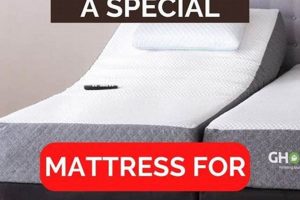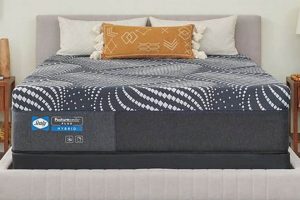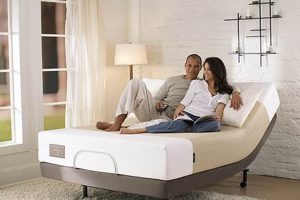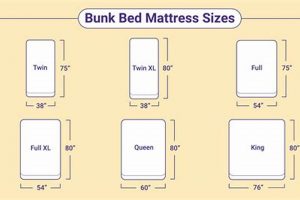Elevated sleeping platforms designed to accommodate a specific, larger mattress size offer a space-saving solution, particularly beneficial in compact living environments. These structures utilize vertical space, freeing up the floor area beneath for alternative uses. For instance, a workstation, seating area, or storage unit can be placed under the elevated bed frame.
The adoption of raised bed systems provides several advantages, most notably optimized space utilization. Functionality increases through the integration of different living areas in a single room. Historically, such configurations were common in shared living spaces or smaller dwellings, emphasizing efficient resource management. Contemporary designs are often implemented to create multifunctional rooms, suitable for both residential and academic environments.
This article will explore the construction materials, safety considerations, design variations, and practical applications related to these space-efficient bed solutions. Further, it will examine criteria for selecting appropriate mattresses and furniture to complement this type of bed frame, focusing on maximizing usability and aesthetic appeal while maintaining structural integrity and user safety.
Optimizing Space with an Elevated Queen Platform
The following tips provide guidance on effectively integrating and utilizing a queen-size mattress within a lofted bed framework. These recommendations focus on safety, functionality, and optimizing the available space.
Tip 1: Measure Ceiling Height: Prior to purchase, accurately measure the ceiling height. Adequate clearance above the mattress is essential for comfortable movement and prevents potential head injuries. A minimum of 30 inches between the mattress top and the ceiling is recommended.
Tip 2: Assess Structural Integrity: Verify the bed frame’s weight capacity exceeds the combined weight of the mattress and its intended users. Review manufacturer specifications and seek professional advice if uncertainty exists. Reinforce the structure if necessary.
Tip 3: Implement Secure Railings: Ensure the bed features safety railings on all open sides, extending sufficiently above the mattress surface. Railings should be firmly secured to the bed frame and constructed from durable materials capable of withstanding sustained pressure.
Tip 4: Select a Supportive Mattress: Opt for a queen-size mattress that provides adequate support and comfort. Consider mattress thickness in relation to the railing height to prevent rollover accidents. Memory foam or hybrid mattresses are often suitable choices.
Tip 5: Optimize Under-Bed Space: Maximize the space beneath the bed by incorporating storage solutions, a dedicated workspace, or a seating area. Utilize modular furniture and vertical storage systems to efficiently organize the area.
Tip 6: Ensure Safe Ladder Access: The ladder or staircase leading to the bed should be stable, secure, and angled appropriately for easy climbing. Implement non-slip surfaces and consider installing handrails for added safety.
Tip 7: Consider Room Lighting: Address lighting needs within the bed area and the under-bed space. Install reading lights, task lighting, or ambient lighting to enhance functionality and create a comfortable atmosphere.
These strategies enable the safe and efficient utilization of a lofted queen-size bed, maximizing available space and creating a functional living environment. Proper planning and attention to detail are paramount to ensuring user safety and overall satisfaction.
The subsequent sections will discuss specific product recommendations and design considerations to further enhance the benefits of this space-saving solution.
1. Space Optimization
The primary impetus for selecting a loft bed designed for a queen mattress often stems from the need for enhanced space optimization within a limited square footage. These elevated bed systems transform vertically unused space into functional areas, creating the effect of a larger living area without requiring structural modifications to the dwelling. The cause-and-effect relationship is direct: the loft bed’s vertical orientation releases floor space, the effect of which is a more usable environment. For instance, in a small apartment, a lofted queen bed allows the area beneath to function as a home office, living room, or storage space.
Space optimization is not merely a desirable attribute; it is a foundational component of the loft bed’s utility. Without it, the inherent benefits of an elevated sleeping platform are significantly diminished. Consider a studio apartment where floor space is at a premium. Replacing a traditional queen bed with a loft version can free up enough square footage to accommodate a small dining table or a comfortable seating arrangement. This transformation is driven by the efficient use of vertical space, allowing for multiple functions within the same footprint. The practical significance of this understanding lies in maximizing the livability and utility of otherwise cramped quarters.
In summary, the implementation of a loft bed for a queen mattress represents a deliberate effort to optimize space. This design choice converts unused vertical space into practical living areas, offering substantial benefits, particularly in smaller dwellings. Understanding the integral role of space optimization in this context allows for informed decision-making and effective integration of this furniture piece into the living environment. The primary challenge remains ensuring the chosen frame’s structural integrity and the user’s comfort and safety, but the space-saving advantage renders it a potentially transformative solution.
2. Structural Stability
The structural stability of a loft bed designed for a queen mattress is paramount, directly influencing user safety and the longevity of the furniture piece. The larger dimensions and weight of a queen-size mattress necessitate a robust frame capable of withstanding significant static and dynamic loads. The effects of inadequate structural integrity can range from minor inconveniences, such as squeaking or wobbling, to catastrophic failures, potentially leading to injury. The correlation between the bed frame’s design and the support required for a queen mattress is a critical engineering consideration.
Structural stability is not merely a desirable characteristic; it is a fundamental requirement. The use of appropriate materials, such as heavy-gauge steel or solid hardwood, is essential for ensuring the frame’s ability to support the mattress and occupants. Reinforcement at critical joints, such as where the ladder attaches or where the support beams connect to the frame, is crucial. Welding or bolting techniques must be executed with precision to maintain the structural integrity of the entire assembly. Real-world examples
of poorly constructed loft beds highlight the potential consequences of neglecting these considerations. Instances of collapsing frames under normal use underscore the importance of rigorous quality control and adherence to engineering standards.
In summary, structural stability is an indispensable component of a loft bed intended for a queen mattress. Neglecting this aspect compromises user safety and diminishes the long-term value of the product. The selection of appropriate materials, meticulous construction techniques, and thorough quality assurance measures are essential for ensuring a stable and reliable elevated sleeping platform. The ongoing challenge lies in balancing structural integrity with aesthetic design and affordability, but prioritizing safety should remain the guiding principle. Subsequent discussions will address specific engineering design features contributing to enhanced structural stability.
3. Safety Railings
Safety railings are an indispensable component of any loft bed designed for a queen mattress. The elevated sleeping platform inherently presents a risk of falls, and the presence of appropriately designed and installed railings directly mitigates this hazard. In their absence, or with inadequate implementation, the potential for serious injury increases significantly. The cause-and-effect relationship is clear: inadequate railings can lead to accidental falls, while robust railings provide a physical barrier to prevent such occurrences. The dimensions of a queen mattress further underscore the importance of safety features due to the larger sleeping surface area and increased potential for accidental rolling during sleep.
The design of safety railings must account for both height and structural integrity. Insufficient railing height may fail to prevent falls, while flimsy construction could collapse under pressure. Regulations and guidelines often specify minimum height requirements for railings on elevated beds. For example, some standards mandate a minimum railing height of at least five inches above the mattress top. The materials used in construction must be durable and capable of withstanding sustained pressure. Real-world examples of injuries resulting from falls from loft beds lacking proper safety railings highlight the practical significance of these considerations. Instances of children and adults sustaining fractures or head trauma due to inadequate safety measures underscore the necessity of adhering to rigorous safety standards.
In summary, safety railings are an essential safety feature of loft beds for queen mattresses, directly addressing the risk of falls associated with elevated sleeping platforms. Compliance with established safety standards, the use of durable materials, and careful attention to railing height are all critical factors in ensuring user safety. The ongoing challenge lies in balancing safety requirements with aesthetic design preferences, but prioritizing user safety should remain the paramount concern. Further analysis will focus on specific design considerations for safety railings, including attachment methods and material specifications.
4. Ladder Security
Ladder security is an indispensable element of a loft bed designed for a queen mattress. Access to the elevated sleeping surface necessitates a ladder or staircase, and the stability and secure attachment of this access component directly impact user safety. The dimensions and weight associated with a queen mattress amplify the importance of ladder security, as users must exert more effort to ascend and descend. An unsecured or poorly designed ladder creates a significant risk of falls, resulting in potential injuries ranging from minor abrasions to severe fractures. The causal relationship is straightforward: an unstable ladder leads to falls, and secure ladder construction prevents these accidents. For example, a ladder with loose rungs or inadequate anchoring to the bed frame poses a direct threat to the user.
Ladder design and material selection are critical factors in ensuring security. Non-slip treads are essential to provide a secure footing, preventing slips during ascent and descent. The angle of the ladder should be ergonomically appropriate to minimize strain and maximize stability. Metal or solid hardwood construction provides superior strength and durability compared to lighter, less robust materials. Proper attachment mechanisms, such as bolts or welding, must be implemented to ensure the ladder remains firmly affixed to the bed frame. Real-world cases illustrate the dangers of inadequate ladder security. Reports of individuals falling from loft beds due to ladder failure underscore the practical importance of adhering to strict safety standards. These incidents frequently involve injuries such as sprains, strains, and fractures, highlighting the potential consequences of neglecting ladder stability. Furthermore, the placement of the ladder should be considered to allow for ample clearance and minimize obstructions to movement.
In summary, ladder security is a non-negotiable safety consideration in the design and implementation of a loft bed for a queen mattress. The stability and secure attachment of the ladder are paramount to preventing falls and ensuring user safety. Careful attention to design, material selection, and attachment mechanisms is essential for creating a safe and reliable access system. The ongoing challenge lies in balancing safety requirements with aesthetic design and user convenience, but prioritizing safety must remain the primary objective. Subsequent discussions will address specific design features and safety standards related to ladder construction and attachment.
5. Mattress Compatibility
Mattress compatibility is a critical consideration when selecting a loft bed designed for a queen mattress. The queen mattress, with its standardized dimensions, necessitates a bed frame engineered to provide adequate support and a proper fit. Incompatible dimensions result in compromised structural integrity and safety hazards. The cause-and-effect relationship is direct: an incorrectly sized mattress either overstresses the frame or lacks adequate support, leading to potential collapse or instability. Failure to ensure proper mattress compatibility compromises the fundamental purpose of the elevated bed system: efficient space utilization coupled with safe sleeping arrangements. For instance, a mattress exceeding the frame’s weight capacity or dimensions places undue stress on the structural components, increasing the risk of structural failure over time.
The structural integrity of the loft bed is directly related to mattress compatibility. Overhanging mattresses create uneven weight distribution, potentially causing the frame to warp or break. Conversely, a mattress that is too small leaves gaps that can create tripping hazards or allow bedding to slip through. The practical application of this understanding extends to the selection process. Precise measurement of the bed frame’s internal dimensions is essential, followed by careful comparison with the mattress specifications. Consideration must be given to both width and length, as well as mattress thickness, to ensure a flush and secure fit. Manufacturers typically provide detailed specifications that must be caref
ully reviewed. Furthermore, the type of mattress (e.g., memory foam, innerspring, hybrid) can influence its suitability for a particular loft bed design. Innerspring mattresses, with their inherent weight, may require a more robust frame than lighter memory foam alternatives. Hybrid mattresses are another consideration that should be considered for that specific frame.
In summary, mattress compatibility is a non-negotiable factor in the successful implementation of a loft bed for a queen mattress. The interplay between mattress dimensions, weight, and frame design directly impacts user safety and the longevity of the bed system. Rigorous attention to specifications and careful selection are essential steps in ensuring a stable and secure sleeping environment. The primary challenge lies in accurately assessing both the frame’s capabilities and the mattress’s requirements, necessitating diligent research and, potentially, expert consultation. Achieving proper mattress compatibility represents a fundamental prerequisite for realizing the full benefits of a lofted queen bed configuration and ensure long term performance and safety.
6. Headroom Clearance
Headroom clearance represents a critical safety and comfort parameter in the context of a loft bed designed for a queen mattress. This parameter refers to the vertical distance between the top surface of the mattress and the ceiling or any overhead obstructions. Insufficient headroom clearance directly impacts the usability and safety of the elevated sleeping platform. The cause-and-effect relationship is evident: inadequate headroom increases the risk of head injuries, restricts movement, and creates a claustrophobic environment, thereby negating the intended benefits of space optimization. Implementing a loft bed for a queen mattress without proper consideration of headroom negates the purpose of creating more space, rendering the bed functionally deficient. For example, a loft bed installed in a room with low ceilings may leave occupants unable to sit upright comfortably, leading to discomfort and potential injury.
The practical implications of insufficient headroom extend beyond mere discomfort. Emergency situations, such as a fire or sudden illness, require quick and unimpeded egress. Restricted headroom can impede rapid evacuation, increasing the risk of harm. Industry standards and building codes often stipulate minimum headroom requirements for habitable spaces, which should be carefully considered when installing a loft bed. Practical application involves precise measurement of ceiling height and consideration of the occupant’s height when seated. This analysis should inform the selection of the loft bed frame and mattress thickness. Furthermore, the placement of lighting fixtures or other ceiling-mounted objects must be carefully considered to avoid further encroachment on the available headroom. Ignoring these practical considerations can lead to significant safety hazards and a diminished quality of life.
In summary, headroom clearance is a critical, often overlooked, aspect of integrating a loft bed for a queen mattress into a living space. Its presence directly affects the user’s comfort, safety, and ability to effectively utilize the space. Attention to detail in measurement, planning, and component selection is essential to avoid the potential negative consequences of inadequate headroom. Ensuring sufficient headroom represents a fundamental requirement for maximizing the advantages and minimizing the risks associated with elevated sleeping arrangements. This parameter must be prioritized to ensure both functionality and the occupants well being.
Frequently Asked Questions
This section addresses common inquiries regarding loft beds designed to accommodate a queen-size mattress. These answers aim to provide clarity and guidance for potential purchasers.
Question 1: What is the minimum ceiling height recommended for a loft bed designed for a queen mattress?
A minimum ceiling height of 8 feet is generally recommended. This allows for sufficient headroom above the mattress and beneath the bed frame, enabling comfortable movement and preventing potential head injuries. However, individual needs and preferences may necessitate a greater clearance.
Question 2: What is the typical weight capacity of a loft bed frame designed for a queen mattress?
The weight capacity varies depending on the materials and construction of the bed frame. Generally, these frames are designed to support between 500 and 800 pounds. It is crucial to consult the manufacturer’s specifications to ensure the frame can safely accommodate the mattress and occupants.
Question 3: What safety features are essential for a loft bed designed for a queen mattress?
Essential safety features include secure safety railings extending sufficiently above the mattress surface, a stable and properly angled ladder or staircase with non-slip treads, and a structurally sound frame constructed from durable materials. Regular inspection of all components is also crucial.
Question 4: What type of mattress is best suited for a loft bed designed for a queen mattress?
A supportive mattress that meets the frame’s weight capacity is recommended. Memory foam, innerspring, or hybrid mattresses are suitable options, provided they adhere to the frame’s specifications. Mattress thickness should also be considered in relation to railing height.
Question 5: How can the space beneath a loft bed designed for a queen mattress be optimized?
The space beneath can be optimized by incorporating storage solutions such as drawers or shelves, creating a dedicated workspace with a desk and chair, or establishing a seating area with a small sofa or armchairs. Vertical storage systems maximize available space.
Question 6: Are there specific building codes or regulations that apply to loft beds designed for a queen mattress?
Building codes and regulations vary depending on location. It is advisable to consult local authorities or building inspectors to determine if any specific requirements apply to loft beds. This ensures compliance with safety standards and zoning regulations.
Careful consideration of these frequently asked questions provides a foundation for informed decision-making when selecting a loft bed. Prioritizing safety and functionality remains paramount.
The next section will delve into practical considerations for assembling and maintaining a loft bed designed for a queen mattress.
Conclusion
The exploration of the “loft bed for queen mattress” configuration has illuminated several crucial facets, spanning from space optimization and structural stability to safety considerations and mattress compatibility. The analysis underscores the importance of meticulous planning and informed decision-making to ensure a functional and secure elevated sleeping environment. Adherence to safety guidelines, compliance with building codes, and a thorough understanding of the bed frame’s specifications are paramount for responsible implementation.
The effective integration of a loft bed for a queen mattress presents a viable solution for maximizing space in compact living environments. However, the success of this strategy hinges upon prioritizing safety and structural integrity. Prospective buyers must engage in careful assessment and diligent execution to ensure long-term utility and minimize potential risks. Further research and continued adherence to evolving safety standards are vital for realizing the full potential of this space-saving innovation.
p>


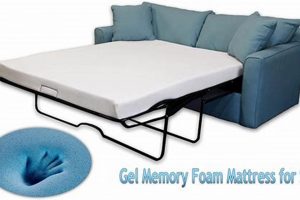
![Best Queen Adjustable Bed & Mattress [Guide & Reviews] Organic & Natural Mattress Buyer’s Guide: Non-Toxic Sleep Solutions Best Queen Adjustable Bed & Mattress [Guide & Reviews] | Organic & Natural Mattress Buyer’s Guide: Non-Toxic Sleep Solutions](https://mattressworldpa.com/wp-content/uploads/2025/07/th-7128-300x200.jpg)
